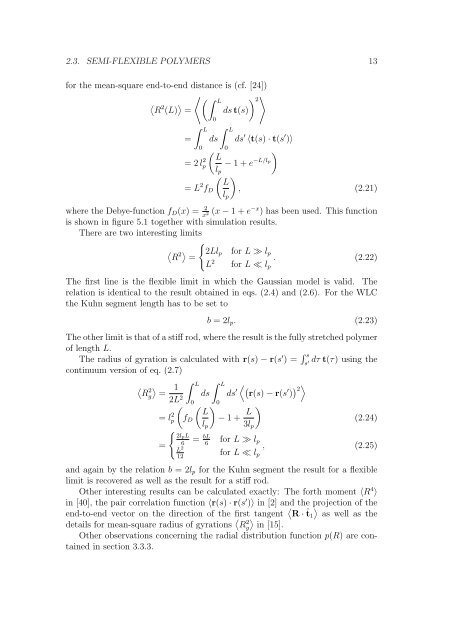Polymers in Confined Geometry.pdf
Polymers in Confined Geometry.pdf
Polymers in Confined Geometry.pdf
You also want an ePaper? Increase the reach of your titles
YUMPU automatically turns print PDFs into web optimized ePapers that Google loves.
2.3. SEMI-FLEXIBLE POLYMERS 13<br />
for the mean-square end-to-end distance is (cf. [24])<br />
L<br />
2<br />
2<br />
R (L) = ds t(s)<br />
<br />
L<br />
0<br />
L<br />
ds<br />
0<br />
′ 〈t(s) · t(s ′ )〉<br />
= ds<br />
0<br />
= 2 l 2 <br />
L<br />
p − 1 + e<br />
lp<br />
−L/lp<br />
<br />
= L 2 <br />
L<br />
fD , (2.21)<br />
where the Debye-function fD(x) = 2<br />
x2 (x − 1 + e−x ) has been used. This function<br />
is shown <strong>in</strong> figure 5.1 together with simulation results.<br />
There are two <strong>in</strong>terest<strong>in</strong>g limits<br />
2<br />
R <br />
2Llp for L ≫ lp<br />
=<br />
L2 . (2.22)<br />
for L ≪ lp<br />
The first l<strong>in</strong>e is the flexible limit <strong>in</strong> which the Gaussian model is valid. The<br />
relation is identical to the result obta<strong>in</strong>ed <strong>in</strong> eqs. (2.4) and (2.6). For the WLC<br />
the Kuhn segment length has to be set to<br />
lp<br />
b = 2lp. (2.23)<br />
The other limit is that of a stiff rod, where the result is the fully stretched polymer<br />
of length L.<br />
The radius of gyration is calculated with r(s) − r(s ′ ) = s<br />
s ′ dτ t(τ) us<strong>in</strong>g the<br />
cont<strong>in</strong>uum version of eq. (2.7)<br />
2 1<br />
Rg =<br />
2L2 = l 2 <br />
p<br />
=<br />
L<br />
0<br />
fD<br />
<br />
2lpL<br />
6<br />
L2 12<br />
L<br />
ds ′<br />
r(s) <br />
′ 2<br />
− r(s )<br />
ds<br />
0 <br />
L<br />
− 1 + L<br />
<br />
lp<br />
= bL<br />
6<br />
3lp<br />
(2.24)<br />
for L ≫ lp<br />
, (2.25)<br />
for L ≪ lp<br />
and aga<strong>in</strong> by the relation b = 2lp for the Kuhn segment the result for a flexible<br />
limit is recovered as well as the result for a stiff rod.<br />
Other <strong>in</strong>terest<strong>in</strong>g results can be calculated exactly: The forth moment 〈R4 〉<br />
<strong>in</strong> [40], the pair correlation function 〈r(s) · r(s ′ )〉 <strong>in</strong> [2] and the projection of the<br />
end-to-end vector on the direction of the first tangent <br />
R · ˆt1 as well as the<br />
details for mean-square radius of gyrations R2 <br />
g <strong>in</strong> [15].<br />
Other observations concern<strong>in</strong>g the radial distribution function p(R) are conta<strong>in</strong>ed<br />
<strong>in</strong> section 3.3.3.













